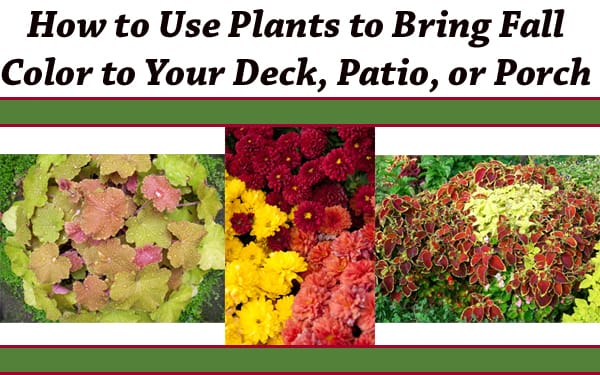Newsletter Articles
How to Use Plants to Bring Fall Color to Your Deck, Patio, or Porch
Written by Susan B.
Fall is the season for vibrant and earthy colors. It combines the colors of the harvest and the colors of the leaves of falling leaves on deciduous trees. The way Californians experience the season may differ vastly from the way New Englanders experience it at the opposite end of the country. But we can still capture the essence of the season through the plants and flowers we put on the decks, patios, or porches of our Southern California homes. We will give you some ideas for transforming outdoor areas where you and your family spend time into a cornucopia of Autumnal colors.
What to Consider Before You Plant
If you plan to put different plant species in a container, make sure that all the plants you want to plant together have the same light, water, and soil texture and pH needs. Choose pots, containers, or planters that are large enough to accommodate your plants — including their root systems. You may also want to think about what you’ll do with your plants once winter comes. Do you intend to transplant what you’re using for fall color on your deck, patio, or porch into your garden, or can you keep the plants in containers – at least for the foreseeable future.
Martha Stewart suggests that successful fall container gardens should include pansies and ornamental cabbages for their cold tolerance, and perennials that bloom late into the season, and combinations of succulents in milder climates.
Plants and Flowers to Consider for Fall Color
Pansies are compact flowering annuals that come in a variety of colors and color combinations. Because they thrive in cooler weather, they’re especially well-suited for use to add fall color to your outdoor living and dining spaces. Pansies will do well with morning sun, but they need protection from the hot afternoon sun. A south-facing patio is an ideal spot for your pansies to grow. Pansies are low growing flowers that grow to a maximum of 6 to 9 inches tall and spread to a width of between 9 and 12 inches.
Chrysanthemums
We can’t think of any other flowering plant that is more synonymous with the fall season than Mums. There are multiple species and cultivars of chrysanthemums. And you’ll find chrysanthemums for sale in a wide variety of quintessential fall colors. Opt for the super-compact cultivars because they’re better suited to growing in containers. And Chrysanthemums produce long-lasting flowers, so you’ll enjoy the blooms for the majority of the season.
Southern Living suggests that the formula for a perfect container garden includes thriller (a tall plant that serves as the focal point), filler (low growing plants that fill in the soil around the focal plant), and “spiller” plants whose function is to spill over the edges of the container. And Sweet Potato Vine is an ideal “spiller” plant. Its appeal (and the thing that draws your attention) is the foliage color. You’ll find Sweet Potato Vine in lime (light)green, chartreuse, burgundy, a deep-almost-black color, red, and cultivars with variegated leaves. Sweet Potato Vine thrives in hot and sunny climates and well-drained soil. And in our mild climate, you’ll be able to enjoy Sweet Potato Vine all winter.
Heuchera – (Coral Bells)
People (including us) probably don’t think of Heuchera as a viable container plant. Although the plant produces non-descript flowers, the plant’s interest lies in its large leaves. Several cultivars have leaves whose colors are ideally suited to use as fall foliage container plants. And because coral bells thrive in partial shade, your covered porch is the perfect spot in which to showcase them. Two outstanding varieties for fall color are “Marmalade,” and “Autumn Leaves.”
Coleus has always been an excellent ceontainer plant. You may not realize that coleus comes in a wide variety of different foliage colors, shapes, growth habits, and plant sizes. And some new and unfamiliar cultivars will give you the color, leaf textures, and growth habit that you want in a container – whether you use them alone, or combined with other green and flowering plants.
Kiwi Fern
Kiwi Fern grows to a maximum height of between one and two feet. It can tolerate shade or sun. Between July and September, it produces baby blue-colored flowers that emerge from tall spikes. And the flowers appeal to hummingbirds. But pinching the buds before they open forces the plant to produce denser foliage. These plants have frilly leaf edges that are creamy yellow at the tips, with a burgundy color that extends from the purple shade that covers the center of each leaf. Kiwi Fern would look incredible when paired with sweet potato vine.
Henna
When you look at this plant from afar, the plant’s leaves appear to be a warm copper color, but when seen from close up, the top of the leaves is a golden-chartreuse color, while the underside of the leaves is the color of burgundy wine. The leaves on Henna have serrated edges. The plant grows to a height and width of two feet. Henna is an ideal plant to include in a fall container that includes mums, or fountain grass.
Our garden experts are always available to help you choose plants to add color to your deck, patio, or porch. They can also help you pick plants that work well when combined in containers.
Do you like what you see? Sign up for our weekly newsletter to get content like this every week!

